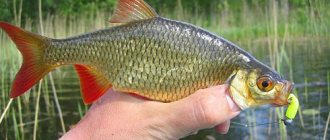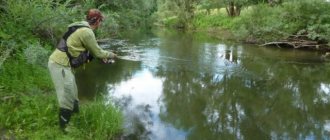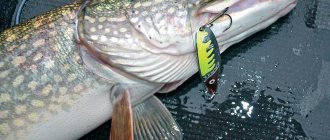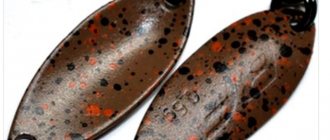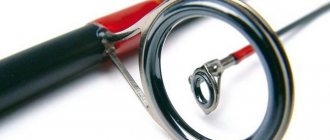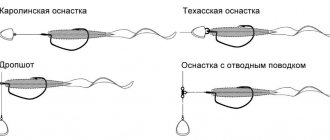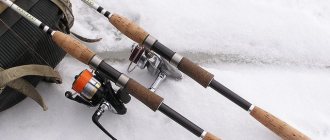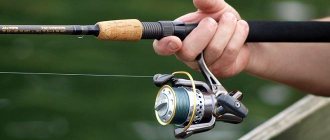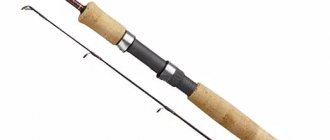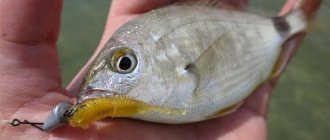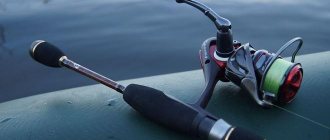Lures are a key element of ultralight tackle. After all, it was their appearance that provoked the subsequent rapid development of ultralight not only as a method of fishing, but as a separate fishing philosophy, like fly fishing or jig. Miniature, weightless spinning lures have made it possible to effectively catch fish with a spinning rod, the capture of which was previously considered an accident. And today, almost all the fish that inhabit our reservoirs, from bleak with goby to catfish and giant pike, can be considered objects for ultralight fishing.
Volume lures for ultralight
Ultralight cranks
All ultralight cranks have a voluminous “pot-bellied” body. The play of such wobblers is quite active, and they do not require jerking movements. The main wiring of all small cranks is uniform at different speeds, for demolition and stop&go. Also, all miniature crankbait wobblers are excellent flyers that can be thrown over a considerable distance from an ultralight point of view. Many of them work stably even in a powerful flow, not to mention a strong current.
The list of catchy ultralight cranks is endless. Of the most popular, it is worth noting :
– Smith Camion family; – the Jackall Chubby family (namely 38F, Diving and DD cranks); – Pontoon Red Rag (models SSR, SR and MDR); – Raiden Maguro Active Crank; – Raiden Mini Fat; – Salmo Hornet; – Zipbaits Baby Hickory; – Akara Mini Crank; – Tsuribito Baby Crank and others.
Minnow
Which minnows are suitable for ultralight. Unlike the same crankbaits, ultra-light minnow wobblers are difficult to throw far. Therefore, they try to use the thinnest cords or monofilament lines with them. It is also worth noting that not all minnows are able to work in the current - many simply go into a tailspin and are pushed by the flow of water to the surface.
Among the well-known ultralight minnow wobblers, the following can be noted::
– Zipbaits Rigge 35; – Pontoon Crackjack 38; – Raiden Silver Minnow; – Raiden Bass Minnow; – Molix Jubarino; – Jackall Tiny Fry 38; – Smith Still; – Jackson Trout Tune.
Sheds for ultralight
In ultralight, voluminous lures in the shad category are poorly represented. It is difficult to explain this approach of fishing producers towards them. Most likely, it is believed that shad are not as relevant in ultralight as in fishing with an adult spinning rod. Although, in our reservoirs, ultralight shad catch almost all fish quite well.
Perch is more often caught with small shad, although not a single pike will let such a voluminous bait pass by. Many chub fish use shad wobblers when catching bigmouth in cold water. The asp also does not disdain ultralight shad. The advantage of many shad over the same minnows is the ability of most of them to work in currents, and sometimes very strong ones.
Among the most popular shads for ultralight fishing are the following:
– Pontoon Cheerful; – Raiden Cranky Shad; – Smith Jade; – Zipbaits Khamsin Tiny.
Hamster - a wobbler and a popper and a walker all in one. This interesting model of a wobbler can be fished using a wobbler, popper and even walker.
Popular types of baits
U30 SERIES is a new series of certified lures that uses natural materials.
U30 VAIN - worm-shaped elastic band up to 5.5 inches long. Silicone imitates a floating live worm and is great for fishing from a boat with a smooth retrieve.
Bait Breath U 30 Rush Craw is a silicone mold shaped like a small crayfish, measuring up to 5 inches. Passive predators are attracted by the movement of the antennae and legs of the bait.
Silicone Bait Breath IM P is a microbait, a favorite bait for crucian carp and small carp. Thanks to the special tail part, the silicone imitates a small fish swimming in the water. There are several levels in this series:
- Level 1 - a cylindrical nozzle with a tail, made in the form of an oval plate with a thin axis. The body and tail are the same size.
- Level 2 - this model imitates an insect falling into the water, floundering on the surface with its wings. It consists of a central ball that holds the silicone, with flat plates attached to the sides.
- Level 3 - the model resembles a shrimp. A ball with hooks is inserted into the middle, and there are ribbed cylinders on the sides. Due to its shape, this edible rubber releases quite a lot of attractant, which attracts fish.
- Level 4 is a ribbed crustacean skeleton with a narrow tail and an elongated head.
- Level 5 - imitation of a goby sea fish, the body is ribbed, there are two heads at the ends.
- Level 6 is the smallest bait, the tail is made in the form of a skirt with fringe, which significantly reduces water resistance.
Manufacturers have released a new product in this series - edible silicone in the form of a worm with a ring body. The place where the hook is attached to the bait was made thicker to reduce the likelihood of tearing.
BYS Vibratwin - imitation of a small crayfish. It has boar hair inserted into it that resembles paws. The ribs are designed in such a way that they can hold air, which increases the buoyancy of the bait. The attractant is saturated with special salts. This taste and smell attracts many types of fish.
DraFla - This rubber nozzle has an air hole that keeps the silicone buoyant. It is better to use it in the warm season. In its shape, DraFla resembles a dragonfly or cicada.
Surface ultralight lures
Topwaters
Surface lures in ultralight also occupy a worthy niche. There are not many of them, and most ultralight users are familiar with these models.
First of all, ultralight topwaters are good for catching boiler perch. Kettle perch hunts on the surface of the reservoir almost all summer. Also, from time to time, white predators attack small walkers and poppers. For example, asp are caught on the spits of large rivers, but chub respond better to surface fish in small rivers.
Ultralight surface baits traditionally appeared in Japan. Local fishermen use such baits when fishing for trout on paid ponds, and topworters often outperform other bulky baits.
Among the most famous surface baits for ultralight, the following can be noted::
– Smith Towadi; – Yo-Zuri Eba Popper; – Jackson T-Pivot; – Smith Jag; – Jackall Chubby Popper; – Uzhgorod stick.
Fishing technique with Bait Breath Bugs
With soft silicone you can catch all types of predators and use various animations. Uniform, classic wiring is suitable for working with baits; it is also recommended to use frequent and long pauses, jumps and vibration.
Due to the serrations on the body and tail, the silicone squirms even during short stops.
Bait Breath Bugs is a universal bait and is suitable for different equipment installations:
- Carolina rig - there is a sinker on the line, followed by a swivel and a leader with a nozzle.
- Retractable leash - a twister is attached to a leash tied to a fishing line, and a weight is put on the other side of the leash.
- Drop shot - a sinker is attached to the end of the fishing line, then a hook, and a bait is attached to the hook.
Silicone baits
Just over the past five years, microjig has made a real splash among spinning players. This coincided with the appearance on the fishing market of edible silicone baits, which turned out to be in great demand by our predators.
The effectiveness of silicone baits made of edible material, which is additionally impregnated with various attractants, has been proven by many experienced athletes and advanced fans of ultra-light spinning rods.
Today the market is flooded with edible silicone baits that can be used in microjig. They are mainly produced by the Japanese, but very successful Chinese inexpensive replicas of the most catchy models also appear.
Among the successful models of silicone baits for ultralight we can note:
– Akara twisters series T-1; – Akara Floating; – Reins G-Tail Saturn; – Imakatsu Javastick; – Bait Breath Fish Tail; – Tsunekichi Worm; – Bait Breath Needle; – Keitech Swing Impact.
Reviews of Akara silicone lures If I started talking about small sizes, I’ll immediately boast about the Akara Rippers & Twisters TL-2 color 123 rubber. The selection story is different here...
Production of edible silicone
Bait Breath has been making soft fishing lures for many years. For each element, certain parameters are selected, taking into account the future load. The taste of the edible attractant is formed from natural ingredients. Production is as follows:
- Professional designers make a sketch of the future product.
- Based on the drawing, a matrix for casting is made.
- Soft silicone is poured into a mold and the texture, color, and hardness of the material are adjusted.
- Minor errors are corrected before the final result.
Spinners
Ultralight turntables have proven their effectiveness more than once. True, unlike microwobblers, small spinners are not so popular. The fact is that microspinners are relatively monotonous baits and many spinning anglers quickly get tired of fishing with them. In addition, ultralight spinners, although small, still spin an expensive thin cord or nylon fishing line.
Rotating spoons for ultralight - lures with a petal size No. 000-1 . The weight of such spinners usually does not exceed 3–5 grams.
These miniature spinners, despite their small size, attract predators from long distances, thanks to the active and rapid vibrations of the petal. Using small spinners you can catch perch, pike, trout, chub, ide, asp, sabrefish, rudd, bleak and other fish.
Ultralight spinners include classic rear-loaded spinners, front-loaded spinners, and various turbines. Today there are many ultralight spinners from nameless manufacturers that do not meet all the requirements of spinning players.
Therefore, when choosing microspinners, you should pay attention only to trusted manufacturers and choose working models:
– Mepps Black Fury; – Mepps Aglia Long; – Akara Action Aglia; – Akara Action Long; – Akara Lite Spin Bee; – Smith Niakis; – Mepps Comet; – Myran Wipp; – Myran Agat; – Panther Martin Original; – Mepps Aglia; – Blue Fox Virax; – Mepps Thunder Bug.
What size is the micro jig?
"Micro" means something small. And small is not heavy in our case. In microjig, as well as in ultralight baits in general, there are also “excesses in places.” Only in microjig “legs grow” on the other side. If in wobblers the main and erroneous criterion for determining “ultralight - not ultralight” is the mass of the wobbler, and the size of the wobbler itself recedes into the background, then in microjig everything is exactly the opposite. More than once I have found information that the main thing is the size of the twister, and the mass of the head is not important. It would be fun to put an ounce (28 g) load into a microjig with an inch twister at the ready! I wonder what kind of delicate rod this alliance will be concluded with? Such equipment certainly has the right to life, and is even quite catchy in places with strong currents. But please, please don’t classify it as a microjig just because it has a small twister. A microjig is a piece of equipment where all possible components (silicone, weight, hook, fastening elements - winding ring, clasp, etc.) are not in conflict with each other regarding size and weight. For example, a small head weight with a large hook can hardly be considered a microjig because a larger hook requires a larger “rubber”. And size, as we noted earlier, is one of the main parameters for UL.
In general, everything is exactly the same as in the formation of real UL gear - there cannot be elements that, according to some criteria, fall out of the general one. Let's say a combination of a "twig" up to 3.5 g at the upper limit of the test and a large heavy coil. The gear will certainly make it possible to somehow catch fish. But, without a doubt, it will be far from the correct balance, in which fishing turns into an aesthetic pleasure, and not a struggle with gear... We already talked about this earlier when creating gear. And today we’ll focus on the sizes of baits and the baits themselves in micro-jigging.
Ultralight Club
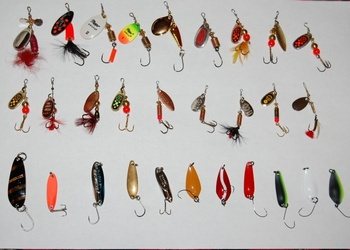
This review does not claim to be complete or accurate, this is just my first experience. Therefore, the choice of bait was dictated not by experience, but by personal preference and advice from fishing sites. All baits weigh from 2.35 g to 6 g. The price category also has a wide range - from a few rubles to 300 for wobblers. All baits, except for the imitation leech, are small in size. No problems were found with the casting range, on average it is 15-20 m. The location of the baits in the review is random, the sequence is not related to their catchability or other characteristics.
So, the first one is the Mepps Aglia Long 00 “spinner” in matte black. It was with this that quite a few small perch were caught on a sunny day. The fishing took place at the bottom of the riffle in a deep barrel under the bank of Kotorosli. The front weight “Cheburashka” of 4 g allows you to cast it far, and also forces the spoon to go near the bottom in a fast current. Thanks to its narrow blade, it works well and does not create much resistance when wiring. After a successful fishing trip, I bought a whole bag of these spinners and tied a fly made of silver-black lurex and red thread on each tee. Perch loves flies on the tee.
White twister “Relax” with “Cheburashka” 4 g. Inexpensive classic twister, catchy, like all their relatives. It is respected not only by perch, but also by any white fish.
Wobbler Kosadaka Beagle XL. Length 43 mm, weight 2.35 g, floating 0.8-1.2 m. Due to the fairly large blade, it plays well even with even winding. It quickly goes a meter deep and catches fish) The game is neat, not sweeping. There is a quiet rattle inside. Outwardly it resembles the food base of Kotorosli predators. The wobbler was to the taste of the ubiquitous perch.
Popper Kosadaka Baby-Pop. Size 40mm (looks smaller), weight 2.5g, naturally floating. Either it catches everyone, or it doesn’t work at all. The first property is manifested in “toads”, with actively feeding predators. The popper then causes everything nearby to attack. There were usually schooling perch and small pike nearby. There is only one tee, but the fish is caught well. When pulled, it produces a quiet gurgling sound and a lot of splashing. In deeper places or in calm periods, the popper was useless.
Yellow twister “Relax” with “Cheburashka” 4 g and offset. It can be pushed through sparse thickets, where predators usually ambush. The color turned out to be more respected than white.
Green twister “Relax” with “Cheburashka” 6 g and offset. Doesn’t cling to algae, which Kotorosl has been suffering from lately. The small bersh liked it.
Wobbler Kosadaka Ion. Length 55mm, weight 4.1 grams, sinking. A wobbler is similar to a bleak fish - the desired prey of all predators. The blade is small, so there is no play with even wiring. This is logical, since the wobbler is designed for jerking. I twitched it near an abandoned beach - the fishing turned out to be very exciting and rewarding. At first I threw it into shallow water and observed which wiring gave it the correct play. It turned out that short sharp pulls were perfect, only the softness of the rod and the monofilament did not allow for a beautiful game.
Wobbler Kosadaka Roger ML. Length 32mm, weight 2.6 grams, floating 0.8-1.2 meters. The fat fish imitates a beetle quite well, so it is quite possible to get the grip of an ide or chub if you throw it under the bushes. The blade is small, the game is neat and weak. The wobbler needs to be “revitalized” with the correct wiring - pulling and tugging.
Spinner spoon Mepps Aglia Long 00 shiny silver color. I carry a couple of pieces in a box. I tied a fly on a tee for everyone and attached a 4 gram Cheburashka. Quite a catchy spinner, but loses to the black one. I don’t know what this is connected with, the dimensions and weight are the same, the only difference is the color of the petal.
Wobbler Pontoon21 Hypnose 38F MDR. Floating, weight 4 grams, size 38mm, working depth 0.8-1.2 meters. The coloring is unconventional, more similar to a beetle due to its shape and gray color. The blade is huge, which makes for a sweeping, intense game. In strong currents this is a disadvantage, but in backwaters the wobbler shows its good side. It interested not only the perch, but also the ide.
Silicone imitation leech, manufacturer unknown to me. The long leech plays perfectly thanks to its shape and very soft silicone. But after a bite, it’s quite possible to be left with nothing, i.e. without a tail. A suitable standard offset machine was installed, which is why the sting was in the first third of the body. This maintained excellent action, but produced many empty bites. When retrieving quickly or in a strong current, the game disappears, the leech stretches out and drags lifelessly behind the sinker. In calm water and with a smooth retrieve, it begins to wriggle, which has a positive effect on the bite.
This concludes the review. In conclusion, I will say that all baits, when used correctly, are catchy. The weakest link is the fisherman.
https://prokarasika.ru/obzor-primanok-dlja-ultralajjta.html
